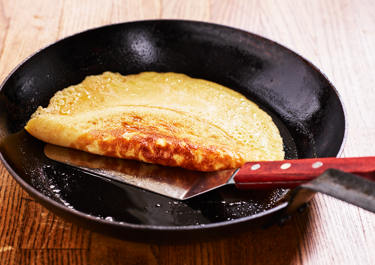
Omelette

Instructions
Omelette
Ingredients
Eggs | 4 |
|---|---|
Milk | 4 tbsp |
Salt | ½ tsp |
Pepper | ½ pinch |
Butter & rapeseed oil | 1 tbsp |
A light and fluffy breakfast favourite
Mornings don’t get much better than waking up to the perfect omelette. Light and fluffy, this recipe is surprisingly easy to make and, with most ingredients already in your kitchen, you can enjoy this breakfast favourite any (or even every) day of the week.
The different types of omelettes
From American and Japanese to Italian-inspired frittatas, omelettes come in many styles. While its actual history is difficult to trace, its name is French and means thin, small plate. The most popular version is said to be the Omelette de la mère Poulard where eggs are vigorously whipped and aerated as much as possible, often with a heavy cream. It is then cooked low and slow with butter in a pan to create the fluffiest, melt-in-your-mouth version that you have ever tasted.
The secret to cooking a perfect omelette
For the perfectly cooked, fluffiest end-result start with room temperature eggs and a dash of milk (or cream). Also make sure that the egg is properly combined: keep whisking until the mixture is frothy with no individual flecks of white. Lastly, only add the eggs to the pan when the butter is completely melted and the bubbles start to die down, the perfect temperature for the perfect omelette.
Some splendid serving tips
With eggs as the star ingredient, you can add almost anything savoury to this recipe. A simple sprinkle of shredded cheese (think cheddar, mozzarella, feta or chèvre) before folding is a firm favourite for many. Herbs like chives, dill, and thyme also add an interesting twist. For a more sophisticated take, add a dollop of sour cream and caviar, a luxurious combination for those special occasions.










&format=webp)